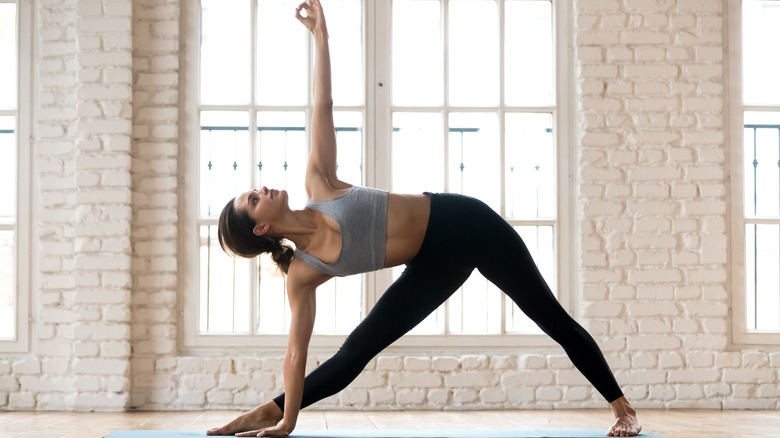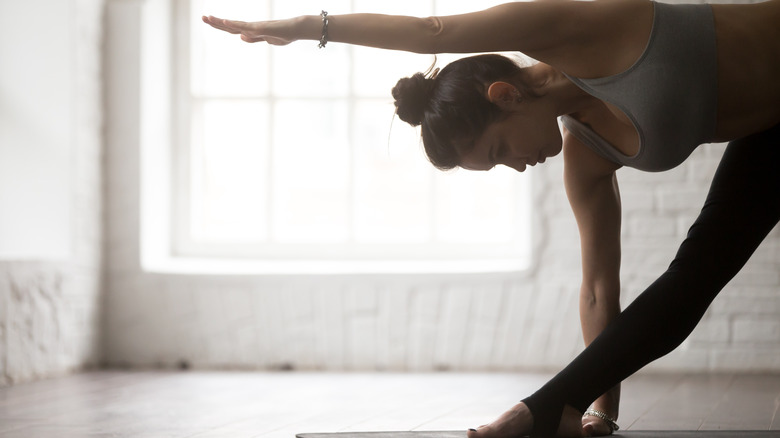Ways To Modify Triangle Pose In Yoga
The ancient practice of yoga has been used to control the breath and bring balance and alignment to the mind and body for more than 5,000 years (per LiveScience). But it wasn't until recently that many Americans began to realize the benefits of maintaining a regular practice.
While we may have been more than a little late to the party, unsurprisingly, we have tried to make up for it with unbounded exuberance. Between 2012 and 2016, the number of Americans who practiced yoga grew by an incredible 50%, according to a survey conducted by Yoga Journal and Yoga Alliance. It's estimated that more than 55 million Americans now practice yoga regularly (per Earth Web).
With so many people doing yoga, it's not hard to imagine that people are coming to the mat with varying degrees of skill and differing states of health. In order to make yoga accessible for everyone who wants to do it, yogis have come up with modifications for many of the traditional yoga poses such as triangle pose.
Benefits of triangle pose, and how to perform the basic version
Used to improve balance, posture, and body awareness, triangle pose, or Trikonasana, is a beginner-level pose that encompasses the whole body (per Yoga Journal). With this one easy pose, you can strengthen everything from your thighs and hips to your core, back, and side body. It also gives you the opportunity to feel a deep stretch in your hamstring, obliques, and chest. In these modern times, triangle pose is an excellent resource for combating hip pain that comes from sitting for too long. In some lineages of yoga, it's even believed that the pose can help to alleviate stress and improve digestion.
To do a triangle pose, you'll start with your feet planted hips-length apart, with the toes of your back foot pointed in the direction you're facing and the toes of the other pointing toward the front of the mat. With your arms outstretched and the back foot acting as an anchor, you'll begin to extend from the hip joint until the side of your body is stretched out over your front facing leg. Once you've stretched as far as you can, you'll then begin to lower the upper body — as if the hip were on a hinge — until it is parallel to the floor. The hand of your front-facing arm will come to the floor for support as your back arm reaches high to the sky. To complete the pose, you'll turn your head to look up at your outstretched arm.
How to modify triangle pose
While a traditional triangle pose is safe for most people to try, there are a few conditions that may require a modified version of the pose. The Expanding Light Retreat explains that the triangle pose is in a classification of poses called inversions, characterized by the placement of the head under the heart. When doing an inversion, the heart has to work against gravity to get blood to all the parts of the body. This, combined with the added pressure of the pose, requires the heart to work harder. For that reason, people with heart conditions can try a modified triangle pose in which the top arm stays planted on the hip. For added support, Art of Living recommends doing the pose with your back body pressed against a wall.
Because triangle pose can lead to significant fluctuations in blood pressure, it's also recommended that people with cardiovascular conditions practice a modified pose in which the gaze is turned to the floor instead of the sky at the final stage of the pose. Additionally, instead of looking up or down, people with neck pain can keep a neutral position and look straight ahead to avoid over straining the neck.



